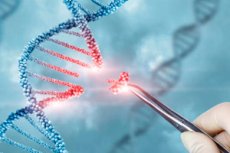New publications
New molecular technology targets tumors and 'silences' two hard-to-treat oncogenes
Last reviewed: 09.08.2025

All iLive content is medically reviewed or fact checked to ensure as much factual accuracy as possible.
We have strict sourcing guidelines and only link to reputable media sites, academic research institutions and, whenever possible, medically peer reviewed studies. Note that the numbers in parentheses ([1], [2], etc.) are clickable links to these studies.
If you feel that any of our content is inaccurate, out-of-date, or otherwise questionable, please select it and press Ctrl + Enter.

Researchers at the University of North Carolina Lineberger Comprehensive Cancer Center have developed a “two-in-one” molecule that can simultaneously disable two extremely hard-to-target cancer genes, KRAS and MYC, and directly deliver drugs to tumors that express these genes. The advance holds particular promise for treating historically difficult-to-treat cancers.
The new technology involves a unique composition of inverse RNA interference (RNAi) molecules that have demonstrated remarkable ability to co-silence mutated KRAS and overexpressed MYC. RNA interference is a cellular process in which small interfering RNAs (siRNAs) selectively turn off, or “silence,” mutated genes. Co-silencing resulted in up to a 40-fold improvement in inhibition of cancer cell viability compared to using individual siRNAs.
The laboratory results were published in the Journal of Clinical Investigation.
“Targeting two oncogenes simultaneously is akin to attacking two of cancer’s Achilles heels at once, which has enormous potential,” said Chad W. Pecot, MD, corresponding author of the paper and professor of medicine at the UNC School of Medicine. “Our inverse molecule represents proof of concept for dual silencing of KRAS and MYC in cancer and is an innovative molecular strategy for co-targeting not only these two genes, but any two genes of your choosing, which holds great promise.”
Mutated KRAS and MYC can jointly promote and sustain aggressive tumor progression through multiple mechanisms, including stimulation of inflammation, activation of cancer cell survival pathways, and suppression of cell death.
KRAS mutations are present in nearly 25% of all human malignancies and are common in some of the most common cancers. MYC is also considered a key oncogene and is dysfunctional in approximately 50–70% of cancers. Several studies have shown that inactivation of MYC significantly suppresses tumor progression, making it a very attractive therapeutic target.
“MYC appears to be nearly as important as KRAS, yet there are no successful drugs targeting MYC,” said Pecot, co-leader of the Lineberger Cancer Therapy Program and director of the RNA Discovery Center at UNC. “Our study is one of the first to deeply characterize the therapeutic implications of targeting both genes simultaneously. We also created the first ‘two-in-one’ molecule that can silence both KRAS and MYC.”
Because most cancers rely on multiple genetic mutations, or drivers, to survive, the technology is especially valuable for targeting two key drivers simultaneously. It has particular potential when both targets, like MYC and KRAS, are critical to a cancer cell’s ability to survive but have historically been difficult to target with drugs. Pecot noted that the unique design features make it possible to already think about silencing three targets simultaneously. “The possibilities are endless,” he says.
This discovery builds on a related result from Pecot’s lab, published in June in Cancer Cell, which described a mechanism for targeting a drug to a specific variant of KRAS, known as KRAS G12V. Now Pecot and his colleagues have developed an RNAi molecule that can suppress all KRAS mutations found in cancer.
While this broader approach is less specific than the previous method targeting KRAS G12V, it has the potential to treat a much larger group of patients, including those with the most common KRAS mutations found in lung, colon, and pancreatic cancers. Together, these cancers will account for nearly half a million new cases in the U.S. this year, according to the American Cancer Society.
“Overall, this is another great example of RNA therapeutics being developed at UNC through the RNA Discovery Center,” Pecot said. “These advances could bring real hope to patients with KRAS-related cancers.”
